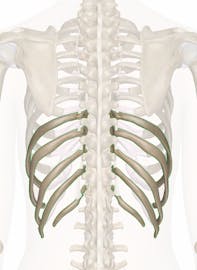The False Ribs
Explore the anatomy and role of the false ribs with Innerbody's interactive 3D model.

The false ribs are the group of five pairs of ribs that do not directly connect to the sternum. They play a significant role in the ribcage by protecting the vital organs of the abdomen while supporting muscles and providing flexibility to the trunk. The false ribs also include the two pairs of floating ribs, which do not connect to the sternum at all.
Anatomy
There are 12 pairs of ribs in the human body, numbered from one to 12, from superior to inferior. The first seven pairs connect directly to the sternum via individual bands of costal cartilage and are known as the true ribs. Inferior to the true ribs are five more pairs of ribs, known as the false ribs, that do not connect directly to the sternum. The first three pairs of false ribs — the 8th, 9th, and 10th ribs — end in costal cartilage bands that continue anteriorly and superiorly to meet at the costal cartilage of the 7th rib lateral to the sternum. Inferior to the 10th ribs are the 11th and 12th ribs, which are a special group of false ribs known as floating ribs. The 11th and 12th ribs are shorter than the other floating ribs and end in short bands of costal cartilage that do not connect to any other bones or cartilage. These ribs do not connect to the sternum and only form a joint with the 11th and 12th thoracic vertebrae on their posterior end.
Like all ribs, the false ribs are flat bones that arise from joints on the thoracic vertebrae. A slightly thickened and rounded head articulates with the vertebra. From the head, the neck extends laterally before turning anteriorly at the angle of the rib. The body of the rib curves around the lateral edge of the thorax toward the chest. At their distal end, the false ribs all terminate abruptly and are capped with a band of costal cartilage. Each rib has a thin layer of compact bone on its exterior and is filled with spongy bone and bone marrow.
Physiology
The false ribs play several vital roles in the function of the thorax and abdomen. They wrap around the superior portion of the abdomen, protecting the liver, kidneys, stomach, and pancreas from external trauma. Several muscles, including the internal and external intercostals, the thoracic diaphragm, and the abdominal obliques, all attach to the false ribs. The intercostal muscles and diaphragm play vital roles in breathing by changing the thoracic cavity volume and subsequently moving air into and out of the lungs.


